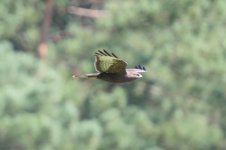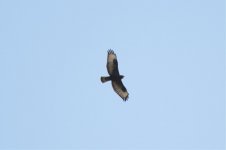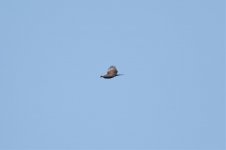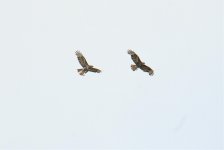Not all Upland Buzzards have feathered legs. Some have partially feathered legs, some don’t have feathering at all. The proportions and size should be more telling
I'm coming back to this discussion to complicate it a bit (sorry) and hopefully learning something from it.
I knew that in Upland Buzzard the tarsal feathering was frequently incomplete (and thus, from the greek, hemi: half, lasius: hairy, i.e. the feathering), but having no feathering at all is new to me. Perhaps I didn't search extensively enough but I could not find any evidence that this actually happens. Do you have any reference to back this up?
A study in Mongolia showed that tarsal feathering is variable, but no bird had totally unfeathered tarsi:
https://sora.unm.edu/sites/default/files/journals/jrr/v033n04/p00323-p00326.pdf
In the same study it is suggested, and perhaps rightly so, that such variability is consistent with hybridization, in this case with Long-legged Buzzard. If this is true, then all other characters, including structure and proportions will be equally affected and likely also unreliable as ID features.
I know it's not frequent to check original descriptions (OD) in ornithology (in an ID context), and it's more usual to do so in entomology for example. The OD of Upland Buzzard describes in detail the feathering and scaling on the tarsi:
https://www.biodiversitylibrary.org/item/223586#page/28/mode/1up
It's in French though. It was called then "Le Buse Demi-pattue", the Half-booted Buzzard (by contrast with Buteo lagopus; note the North American ssp is included there as a different species, with important differences in structure being pointed out). The distinctiveness of the new species is actually mainly based on this feature.
The illustration of the species shows the
type specimen:
https://www.biodiversitylibrary.org/item/223586#page/171/mode/1up
The outer 1/3 of the tarsus in the type specimen was unfeathered (but all feathered in the inner side) and this and some of the photos and descriptions on the paper I posted above lead me to think that the tarsal feathering could be difficult or impossible to detect in a photo such as the first one in post 1 (where you see only the outer side of the tarsus, and not its full length).
This is likely to be much more complicated than I thought initially, with potential hybridization being an obstacle to put a name on less than typical birds.
PS: also relevant:
http://centrostudinatura.it/public2/documenti/434-62558.pdf










